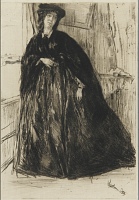Etchings Institutions search term: grolier club
Finette | ||
| Number: | 61 | |
| Date: | 1859 | |
| Medium: | etching and drypoint | |
| Size: | 293 x 202 mm | |
| Signed: | 'Whistler.' at lower right (3); replaced with new 'Whistler.' at lower right (4-final) | |
| Inscribed: | '1859 -' at lower right (3); replaced with new '1859.' at lower right (4-final) | |
| Set/Publication: | 'Cancelled Plates', 1879 | |
| No. of States: | 14 | |
| Known impressions: | 38 | |
| Catalogues: | K.58; M.58; T.56; W.54 | |
| Impressions taken from this plate (38) | ||
TECHNIQUE
While Finette was begun with a few outlines in pure etching, Whistler went on to complete the plate in drypoint, and it is one of a small group of drypoints - Whistler's first - done in 1859. Most are portraits, namely Whistler with a hat
[44], Z. Astruc, Editor of 'L'Artiste'
[36], Fumette's Bent Head
[58], C. L. Drouet, Sculptor
[35], and Arthur Haden
[66].
This plate was the first of Whistler's intaglio prints to be extensively re-worked, probably over some years, as he continued to refine the details and shading of the figure's setting through 14 states. 24 While it is clear that he made a number of additions to the drypoint shading on the frock and cloak, it is difficult to determine those changes precisely; most impressions of Finette were printed with heavy inking in those areas, and individual lines are difficult to discern.
After the copper plate was cancelled, it was purchased by the Fine Art Society and published in a set of cancelled plates (see printing, below). Someone clearly had thoughts of further extending the plate's printing life through removal of the cancellation lines, as evidenced by restoration of the copper plate and the existence of proofs with cancellation removed.
PRINTING
One of the earliest proofs ( ) was worked on in pencil, suggesting amendments to her left hand; it is a fine impression, the fresh drypoint lines printing with a rich burr, possibly augmented by retroussage, and the lines have a soft quality, almost like charcoal. Impressions of the seventh state, where the drypoint was fully added over the whole surface of the domino to convey its silky richness, are particularly lustrous and rich, both from the drypoint burr and a slight use of retroussage (
) was worked on in pencil, suggesting amendments to her left hand; it is a fine impression, the fresh drypoint lines printing with a rich burr, possibly augmented by retroussage, and the lines have a soft quality, almost like charcoal. Impressions of the seventh state, where the drypoint was fully added over the whole surface of the domino to convey its silky richness, are particularly lustrous and rich, both from the drypoint burr and a slight use of retroussage ( ,
,  ). Later impressions were also printed to take full advantage of the burr of the reworked drypoint (
). Later impressions were also printed to take full advantage of the burr of the reworked drypoint ( and
and  ).
).
 ) was worked on in pencil, suggesting amendments to her left hand; it is a fine impression, the fresh drypoint lines printing with a rich burr, possibly augmented by retroussage, and the lines have a soft quality, almost like charcoal. Impressions of the seventh state, where the drypoint was fully added over the whole surface of the domino to convey its silky richness, are particularly lustrous and rich, both from the drypoint burr and a slight use of retroussage (
) was worked on in pencil, suggesting amendments to her left hand; it is a fine impression, the fresh drypoint lines printing with a rich burr, possibly augmented by retroussage, and the lines have a soft quality, almost like charcoal. Impressions of the seventh state, where the drypoint was fully added over the whole surface of the domino to convey its silky richness, are particularly lustrous and rich, both from the drypoint burr and a slight use of retroussage ( ,
,  ). Later impressions were also printed to take full advantage of the burr of the reworked drypoint (
). Later impressions were also printed to take full advantage of the burr of the reworked drypoint ( and
and  ).
).Kennedy comments that in the impression of his ninth state, 'The skirt of the gown in the original impression is badly inked, while some of the delicate lines are faint or do not appear in the reproduction.' (see  ). 25
). 25
 ). 25
). 25
25: Kennedy 1910 (cat. no. 58 V - his fifth state).
